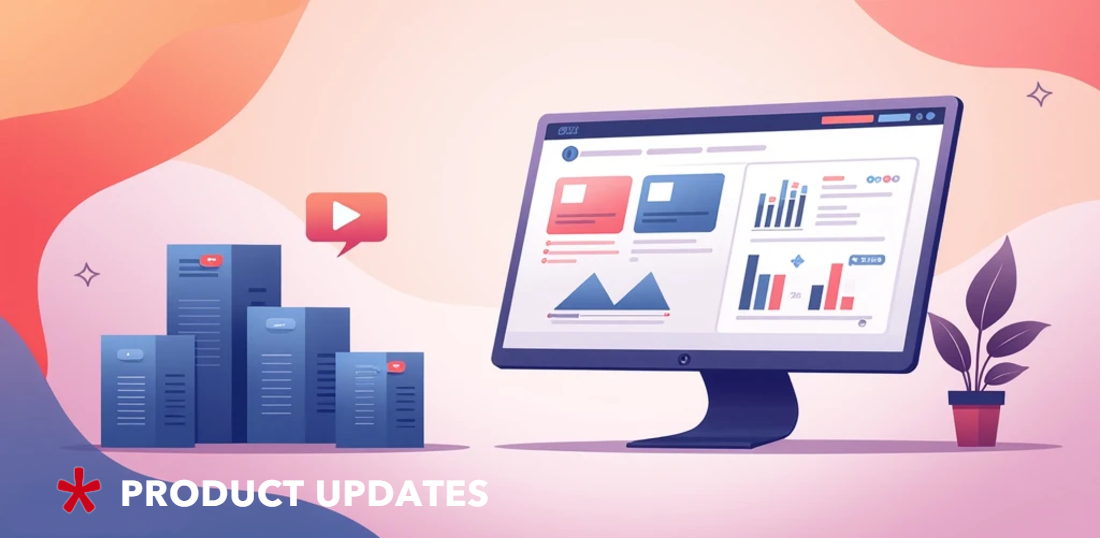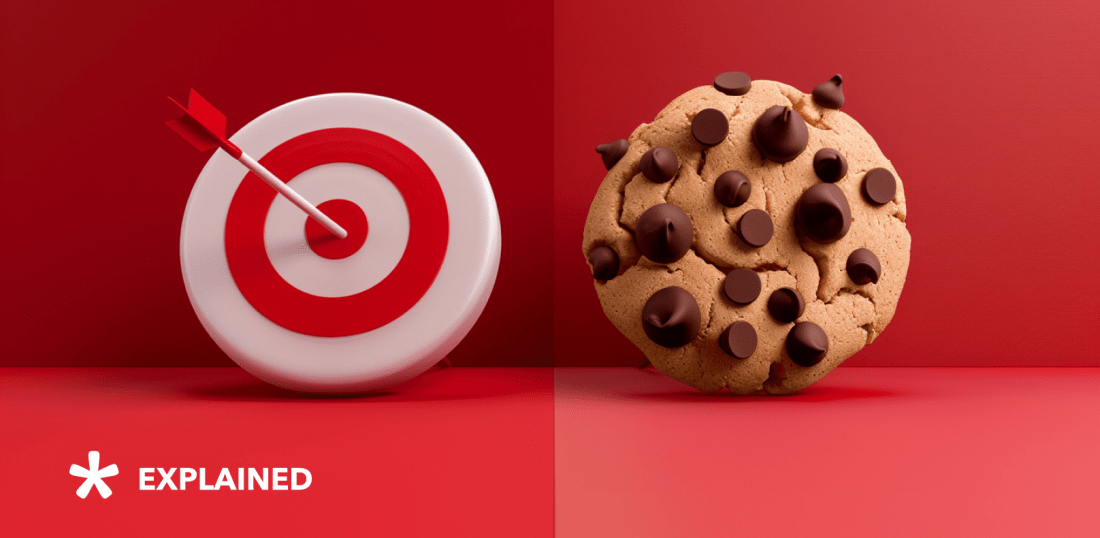
The Best Mobile Ad Types and Formats 2021: A Comprehensive Guide
At the beginning of 2021 (According to Statista) there are 4.66 billion active mobile internet users. Beyond the rise of advanced ad technologies like header bidding solutions, the choice of mobile and in-app formats carries a significant impact, attracting almost 78% of daily online users. This fact inevitably boosts ad growth. Let’s run through the best mobile ad types and formats.
Depending on where specifically users will interact with ads, it can be categorized as mobile web advertising or in-app ads. The key difference is simple: mobile web ads are placed on mobile versions of websites and platforms, while in-app ads are displayed in various applications, as it comes from its name.
Both options bring their benefits to advertisers – and users. Here’s a brief overview of what advertisers can get by placing ads each way.
- Mobile web advertising
- In-app advertising
- Advertising in games
- In-Game Ads
- Types of in-game ads
- Rewarder ads
- Playable Ads
- Standard mobile ad formats
- Mobile banner ads
- Native Ads
- Mobile Video Ads
- Mobile Rich Media Ads
- Interstitial ads
- Mobile Swipe Ads
- Scratch Banner Ads
- Mobile Cube Ads
- When To Use Different Ad Types?
- Standard banner ads
- Video ads
- Native ads
- How to Improve Your Ad Performance
- Strive for the short-form content
- Gamification is the way forward
- A/B test
- Personalize
- What’s next?
Mobile web advertising
So far, users spent 13 minutes a day on mobile websites, according to eMarketer. By 2022, that will likely drop to 12 minutes daily. However, even though users spend more and more time in apps, mobile web ads still offer advertisers a wider range of properties in terms of ad formats.
Also, with mobile web ads, advertisers can reach audiences using standard ad formats, like mobile web banners, video ads, and more making it much easier for advertisers to make a creative that would be perfectly displayed on desktop and mobile devices.
Thus, mobile web ads are great for cross-platform ad campaigns, letting to reach an audience across a variety of platforms using just one version of an ad. Besides, compatibility creates a better user experience for the customer, who will be more apt to click on an ad that looks like it belongs on a site.
Mobile web ads are also a cost-effective option. Due to the responsiveness and auto-resizing of ad formats, advertisers will have no trouble when new smartphone and tablet screen sizes and resolutions are launched as they won’t need to create new ads in all kinds of changing sizes.
Looking how to increase your mobile ads revenue?
Learn how you can do that with Admixer App Monetization.
In-app advertising
The most significant advantage in-app ads bring to advertisers and app developers is the amount of time that users spend with applications.
According to eMarketer, 89% of mobile usage time is spent in-app.
Alongside with this, in-app ads provide a better user experience. Even though ‘nobody likes ads’, apparently, some advertising is more tolerable and even found attractive and likable than others. With this in mind, advertisers can focus on in-app ads to create better ad experiences.
Being less distracting, highly interactive and engaging, and better controlled and managed in-app advertising keeps attracting the interest of advertisers and brands.
Along with the growing army of apps users, advertisers’ interest and willingness to invest into in-app ads keep increasing, too.
A study conducted by Forrester found that 70 percent of advertisers and agencies spending at least $1 million every month on digital advertising are going to increase their in-app ad budgets in the following 12 months.
What’s so attractive in placing ads in the application? First, in-app ads is a great solution to address various goals: increase conversions, user retention and engagement, brand awareness, and drive overall revenue generation.
Plus in-app ad fits nearly every vertical, from social media, news and entertainment apps, to shopping, education, fitness, healthcare, banking, messaging apps, games, and beyond.
Advertising in games
Since gaming apps are among the most popular apps in terms of audience amount and time spent, these formats are worth mentioning separately from general in-app ads.
In-Game Ads
There can be various types of mobile advertising: rewarded video, offerwall, and interstitial ads.
Rewarded video ads intend rewards of benefits to a user for watching the ad, offerwall may contain lists of items a user can pick in exchange for receiving in an in-app reward. As for interstitials, we’ll touch upon this format later in the article.
These formats are great for promoting special offers, new arrivals, upcoming events, and more. Game ads work for a wide range of verticals: sports, beauty, e-commerce, beverages, even real estate companies, and so much more brands can leverage game ads. The main point here is relevance to the audience, context of the game, and right ad placement.
Generally, this type of ads brings the best out of the in-app ecosystem: interactivity, engagement, and memorable user experience.
Pros:
- High interactivity
- Cost-effective
- Universally supported
Types of in-game ads
Rewarder ads
Rewarded Video is a type of video ad that encourages users to watch it for a reward. Usually shown during an online game and for viewing ads gives players equipment for heroes, additional bonuses or lives, virtual currency, hints, etc. Use this format if you need high user engagement.
Playable Ads
This format represents an interactive type of ads that give users an opportunity to try out the demo of an app or game before installing it.
All interaction takes place in the ad unit directly. The best part is that users like these mini-games because of it’s pleasant mobile phone advertising experience and full involvement. Playable ads typically last from 15 seconds to minute.
Pros:
- Interactivity
- High conversions
- Users engagement and retention
Did you know that ads in games can be seamless and truly immersive?
Learn more – request a demo of game ads inventory: tsichko@admixer.com
In terms of interactivity and elements that encourage viewers to engage with the content, there are standard mobile display advertising and mobile rich media ads.
Standard mobile ad formats
Mobile banner ads
Mobile banner advertising is the most common format due to its simplicity and possibility to yield higher CPMs thoughtful placement. Mobile ad banners are displayed in static ad units often placed at the top or bottom of the screen of the device.
Mobile banner ad sizes may vary, but the most standard banner sizes are 320×480, 300×250 and 320×50 for smartphones and 728×90, 768×1024 and 300×600 mobile ad units for tablets.
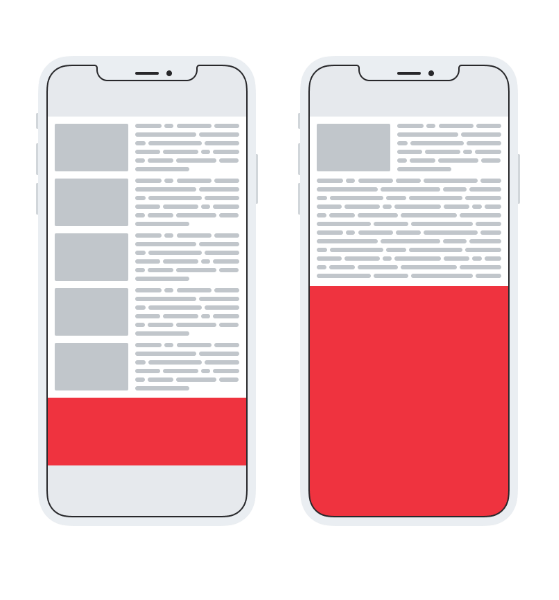
One of the most popular banner sizes is 320×50 mobile ad. Its success is due to its low price for advertisers. Big brands can leverage its minimal space for mobile ad campaign focused on increasing of brand awareness, while mid-size and small brands still can use this banner size to put the essential information about their offer. Plus it provides great user experience, as a mobile banner is non-intrusive and doesn’t interrupt user from the content.
Mobile ad banners design requires a careful balance between eye-catching and bringing too distracting experience. Best mobile banner ads should highlight key features or provide an offer with a clear and compelling call to action without too much text though.
Some interesting findings on mobile banner advertising by InMobi: on Android, the highest banner ads conversion relates to lifestyle content (2.02%); on iOS, banner ads works best for classified content (2.7%).
When is it a good idea to leverage this ads type? If you want to increase your brand visibility for a comfortable price among people who are your potential consumers, then mobile banner ads can be a reasonable investment.
Pros:
- Available on all screens
- Available at low price
- Fast and easy to deploy
- Non-obtrusive for user experience
Native Ads
Native advertising on mobile appears in different sizes and forms. As it comes from the name, native ads are user-centric and organically fit into the context of the place where it appears. Accordingly, this format is perceived as relevant useful information in the flow that increases the chances for the ad to be clicked on.
Native ad imitates the appearance of the contextual environment, so its sizing might also be inherited, but it can be harder accessing the demand, so it might be better to try out 320×480, 300×400 or other typical sizes.
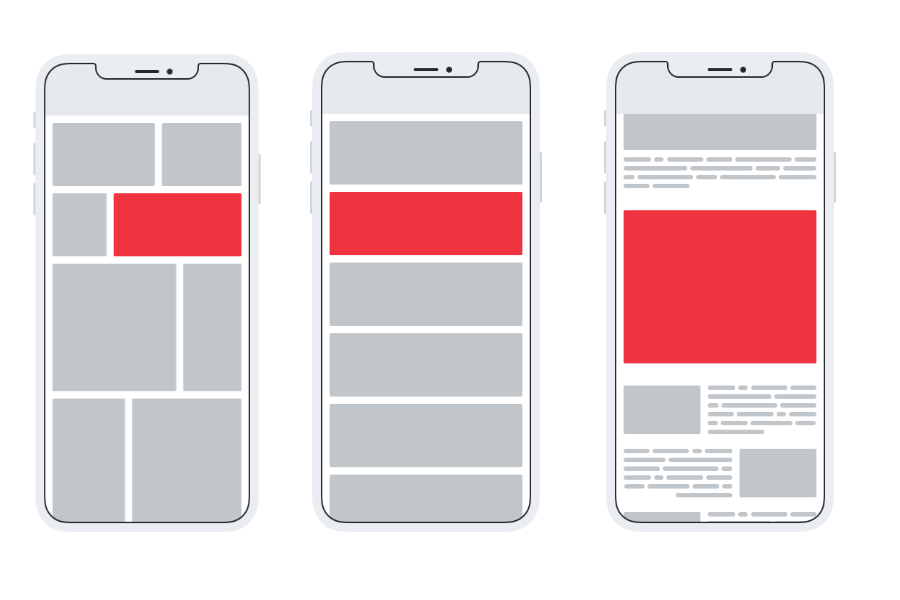
To bring great user experience and look seamless, the ads can come as an icon, feed or in-stream content. Here’s when it’s a good idea to use each of formats:
- Icon ads that can be easily displayed in apps with a multi-tile layout, such as news and entertainment
- Feed ads blend well with user-generated content in a chat list.
- Rich in-stream ads mimic the app’s content feed – ideal for mobile ad campaigns in social networking apps.
This format is similar to banner ads, but it doesn’t take up some fixed screen space or the full display and it’s less of an eyesore and non-disruptive because of its”native” look and feel.
With this type, ads will appear contextually appropriate, for example displaying the ad of cosmetics placed in the middle of an article on a beauty blog. This seamless placement makes native advertising highly effective resulting in impressive CTR.
Native advertising presents a unique opportunity to share your brand story. The combination of visual, headline, and description allows advertisers to state their message clearly and convincingly, and give extra information on the benefits, values, and story behind the product or service.
Pros:
- Unobtrusive and contextually appropriate
- Higher CTR
- Better ad engagement rate
- Advanced user experience
Mobile Video Ads
This format is represented by pre-, mid- or post-roll videos seamlessly appearing in accordant place of the video. It’s supposed to be 320×480 or 480×320 sizes for smartphone and 768×1024 or 1024×768 for tablets. Also, 320×250 sizing is acceptable for outstream videos.
Read more about mobile video ads here.

A typical video ad runs for 15 or 30 seconds when user tap to play. With the growing popularity of shooting vertical video (mainly for social media), video ads also evolved to both horizontal and vertical options.
Accurate placement of mobile video ads can boost the high engagement of the audience. Specifically, placing it at a natural break in the users’ app journey is a good practice. Also, advertisers should think creatively when introducing a video to the users, as an attractive preview screen encourages users to play the video. To minimize the risk of frustrating the users, it’s a common practice to serve autoplay video with muted sound letting users turn it on and off.
According to numerous perspectives, mobile video play rates are higher on in-app (14.0%) compared to mobile web (8.3%).
Mobile video ads are the best way to engage your audience and ensure your brand’s presence at the point of purchase. This ad type works great when appearing on native environments and is similar to all the other content in terms of format and style, like on social and regular media. Mobile video ads fit nearly any purpose – from promoting product or service to telling a brand story.
Pros:
- Users percept video ads good
- Focuses attention
- Good for advertisers
Mobile Rich Media Ads
Mobile rich media ad formats can be represented by videos, GIFs, audio and other content leading the user to interact with the ad inside the mobile ad units without transitions to other pages or sections.
They can have numerous animated effects like expanding, unfolding, parallax, floating, and more – or stimulate user’s actions, for instance, “scratch”, swipe or shake the image on the screen to thereby boosting the conversion.
Looking for more mobile rich media ads?
Check creative formats, available in Admixer Ad Gallery.
As rich media ads are designed to catch the eye and engage, this may also pose an intrusive threat. Therefore, it is crucial to make sure that creative doesn’t go overboard.
On the other hand, according to IAB survey, interactive banners are 25% more likely to recall an ad than those exposed to static banners.
Pros:
- Interactive and eye-catching
- A simple process of implementing
- Engaging user
- Opportunity to measure the number of times users view the ad content
Here’s a sneak peek of several most engaging creative ad formats.
Interstitial ads
Mobile interstitial ad is a full screen advertisement that can be interactive and is displayed at the transition points like loading or closing the app, between game levels, while pausing or when the user is trying to switch the section in the app.
The most common sizes of interstitials are 320*480 and 480*320 for smartphones and 1024*768 and 768*1024 for tablets.
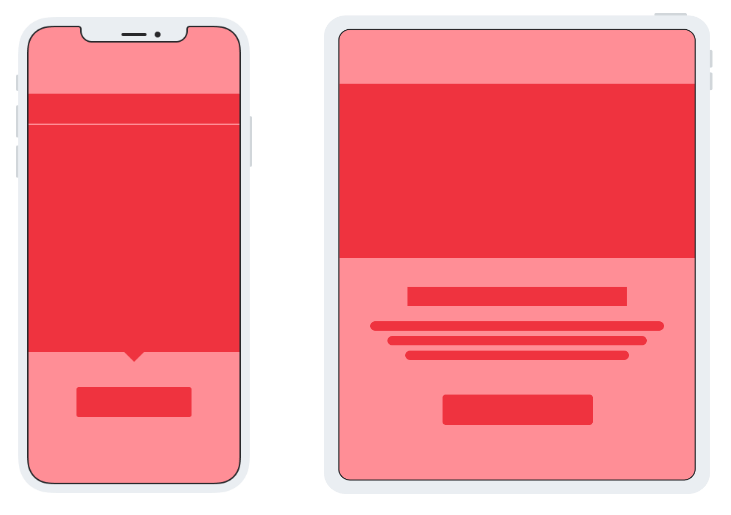
Interstitial mobile ads are adopted straight from the web and fit mobile devices perfectly. With this format, advertisers win user’s undivided attention and don’t have to worry about wrong click-throughs, as ads appear in between pages only without interrupting the user.
The interstitial mobile ads allow advertisers to create mobile ad campaigns fueled with beautiful and engaging content with high-quality visual and compelling copy. This can reduce the disruption factor for users. However, this type of ads needs to be managed properly in order to avoid the excessive frequency of views.
Normally, interstitial ad requires user action like to click a button to close the ad or swipe to navigate to the desired content. So when it comes to picking the right place and moment to place the interstitial ads, advertisers should pick carefully. For instance, when used in games, it’s better to put interstitial mobile ads within games with levels. Such a break is pretty naturally, thus showing ads won’t deliver any obtrusive experience for users.
As for use cases, interstitial ad is most attractive format for brand advertisers from nearly any domain.
Talking about the performance of this ads format, it has 2-3x higher CTR compared to banner ads (InMobi).
Pros:
- Offering more ad space for a broader message
- Visually compelling and memorable
- High impressions and CTR
- Interactive
Mobile Swipe Ads
Mobile Swipe is hugely adaptable and can be used in many ways like highlighting a product, demonstrating its usage or performing a product tour. Using habitual interaction with mobile device – swiping – this format invites users to swipe through the images, each of which goes as a single ad unit and with a link to its own landing page.

Pros:
- Fits perfectly for online shopping platforms and ecommerce
- Engage the audience
Scratch Banner Ads
Similarly to lottery tickets where you needed to scratch the shiny upper layer with a coin to reveal a prize, mobile scratch banner ad engages users to do that digitally. Using a finger a user “scratches” the banner on the mobile screen and reveals the image beneath.
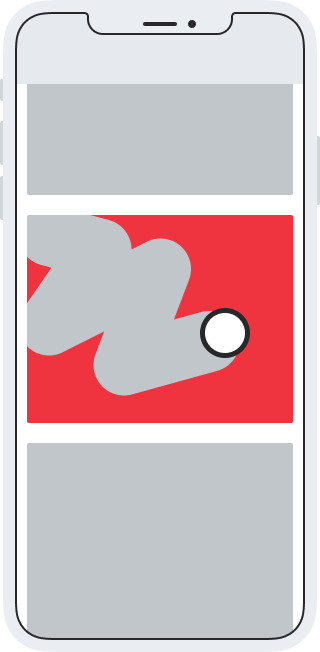
Pros:
- Works perfectly for special offers and discounts
- Interactive and engaging
- Entertaining
Mobile Cube Ads
Being one of the most popular ad formats, mobile cube allows advertisers to showcase up to six images and a video on its six sides. A cube can spin automatically or by swiping, engaging users to interact with one of the ad messages.
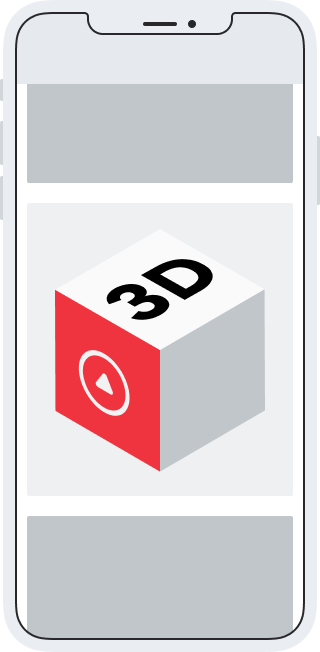
Pros:
- Encourages audience to interact with the ads
- Catchy yet unobtrusive
When To Use Different Ad Types?
Standard banner ads
Among other types of mobile ads, banner ads are relatively cheap to use, making them attractive to companies looking to increase their brand awareness. The main thing to remember when betting on this ad format is that you should invest in a high-quality, non-trivial design to avoid the so-called “banner blindness” caused by countless banner ads on the web. Also, make sure that you use the best mobile banner ad size. Another critical factor is that your banners shouldn’t cover essential parts of the interface or appear when least expected. The best strategy is to place them during the natural pauses in game-like mobile interstitial ads.
Banner ads can be a perfect solution for a short-term and flexible advertising campaign. However, they are quickly forgotten and lost among the ever-popping, more attractive, and complex mobile ad formats. If the ad is too small, it can be easily overlooked, while if it is too big, you are getting a negative reputation with your obtrusive message. The best mobile banner ad sizes include: 300 x 250, 728 x 90, 320 x 100 336 x 280 and 480 x 260.
Video ads
A video ad is a format that can not only improve conversions but also captivate the users’ attention. Video is one of the most favorite content types. Consumption of this format exponentially grew since the beginning of the pandemic.
Video ads provide a better user experience and increase the average effective CPM when the video is between 20 and 35 seconds long. This is enough to memorize the ad message without getting annoyed. Many experts believe that video is the best format for mobile ads because it increases conversions, engages users, and performs better than any other ad type in this environment. However, this option can be quite costly, both for production and placement and there is always the possibility that the user will miss or don’t like the ad.
Native ads
Mobile native ad formats are in-feed ad units that integrate seamlessly with app content (via icons or a short description). This kind of mobile advertising belongs to formats that do not create discomfort for the user since they fit organically into the interface, content feed, or video.
Native ads are often cited as the best mobile ad format as they generate 53% more views than banners. Moreover, some users share native ads by accident, confusing them with the site’s main content.
How to Improve Your Ad Performance
Strive for the short-form content
Shoot a series of short videos. The typical 30 second time for a commercial is too long to run on mobile devices. Users prefer to skip ads, and a lot of time additionally contributes to this. But videos from 3 to 6 seconds long do not cause any negative, and they are easier to watch. Build a sales funnel with a chain of videos and show them as a series for the same user.
Danone released 18 short videos promoting mineral water in 2017. The videos were dedicated to different character traits, the length of each – up to 6 seconds. As a result of the campaign, the number of views was more than 10 million, the cost per 1000 impressions was 25% lower than planned. As a result of the campaign, brand awareness increased by 5%. The campaign was successful thanks to the short format and strong brand message.
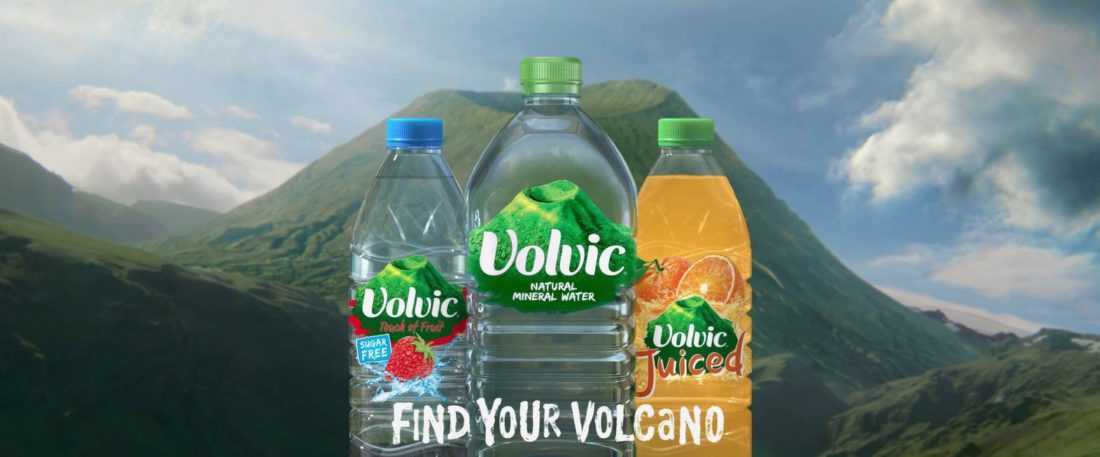
Gamification is the way forward
Incorporate gamification into your ads. Rewarded video and playable ads are formats that engage users in playing a game or watching ads. Due to the playful format, such ads’ conversion rate is higher than for any other top mobile digital ad formats. Come up with custom prizes or games to increase engagement. Remember the required target action and motivate users to take it.
Rusty Lake has incorporated rewarded video into a Twin Peaks-style online game. As a reward, players receive hints to progress to the next level. The game is addictive, but difficult to complete, so the hints are very popular.

A/B test
Test different targeted actions. Most often, a link on a banner leads to a company page or a promotion, but the number of possible options is much greater. Reduce the time between viewing ads and make a purchase by adding useful actions to a click: call, add a product to the cart, download a promotional code for a discount, add an address to the map.
Personalize
Tailor ads for each user. Programmatic platforms are capable of narrowly targeting the audience and showing ads only to the desired user segments. Create a unique ad creative for each segment that meets its needs. Experiment and optimize your mobile ad units with the dynamic creative optimization (DCO). A creative can be assembled piece by piece like a puzzle fully-automatically, changing elements to interact with a specific user, testing their reactions, and making optimization decisions. Optimize and a/b test not only banner images but also videos that you create for your campaigns. Such ads increase engagement because they are tailored and optimized for a specific person.
What’s next?
There are lots of types and formats of mobile ads and new ones appear from the nature of the case. Whenever you are ready to give a try with ad formats to drive your mobile ad campaign – contact Irina Kostiuk, Business Development Executive: ikostyuk@admixer.com.


